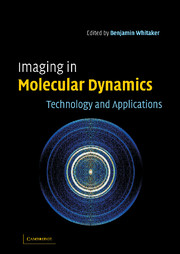Book contents
- Frontmatter
- Contents
- List of contributors
- Preface and acknowledgements
- List of abbreviations
- Part 1 Technology
- 1 Charged particle imaging in chemical dynamics: an historical perspective
- 2 Velocity map imaging: applications in molecular dynamics and experimental aspects
- 3 Reconstruction methods
- 4 Orientation and alignment
- 5 Time resolved cameras
- 6 3-D Imaging technique – observation of the three-dimensional product momentum distribution
- 7 Photoelectron and photoion imaging with femtosecond pump-probe time clocking
- Part 2 Applications
- Index
6 - 3-D Imaging technique – observation of the three-dimensional product momentum distribution
Published online by Cambridge University Press: 07 August 2009
- Frontmatter
- Contents
- List of contributors
- Preface and acknowledgements
- List of abbreviations
- Part 1 Technology
- 1 Charged particle imaging in chemical dynamics: an historical perspective
- 2 Velocity map imaging: applications in molecular dynamics and experimental aspects
- 3 Reconstruction methods
- 4 Orientation and alignment
- 5 Time resolved cameras
- 6 3-D Imaging technique – observation of the three-dimensional product momentum distribution
- 7 Photoelectron and photoion imaging with femtosecond pump-probe time clocking
- Part 2 Applications
- Index
Summary
Introduction
As we have seen in the previous chapters inversion algorithms are required in conjunction with two-dimensional (2-D) detection methods in order to reconstruct the velocity (speed and angle) distributions of the products of photodissociation processes. Since these generally need to make certain assumptions about the symmetry of the measured distributions it would be desirable to measure the velocity distribution directly by making a simultaneous measurement of the position and arrival time of each of the photoproducts. In the previous chapter we saw how two charge-coupled device (CCD) cameras can be used in conjunction to make such a measurement. The present chapter develops this idea further by describing a newly developed three-dimensional (3-D) photofragment imaging technique. In this context the term ‘3-D imaging’ refers to the simultaneous measurement of all three coordinates of a single particle, which are defined by the spatial position in the 2-D surface of the position-sensitive detector (PSD) and by the time of arrival at the detector (the third dimension) of the ionized product of a photodissociation process. The transverse velocity components (vx, vy) of the initial velocity of the product are determined from the measured 2-D impact position on the PSD surface, while the measured time of arrival gives the longitudinal component (vz) of the velocity. Hereafter the laboratory axes X, Y, and Z are directed along the laser beam, the molecular beam, and the accelerating electric field, respectively (Fig. 6.1).
- Type
- Chapter
- Information
- Imaging in Molecular DynamicsTechnology and Applications, pp. 138 - 164Publisher: Cambridge University PressPrint publication year: 2003
- 1
- Cited by

